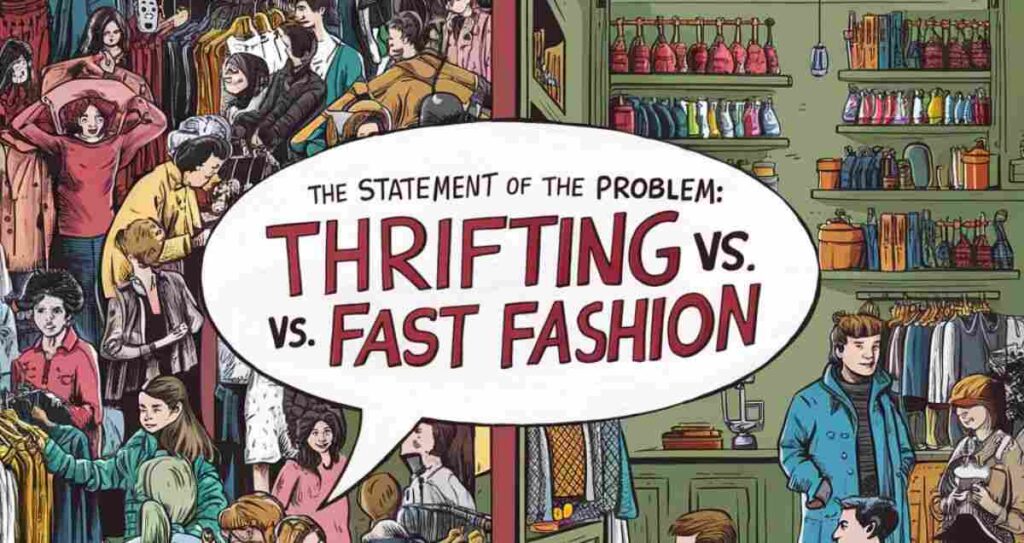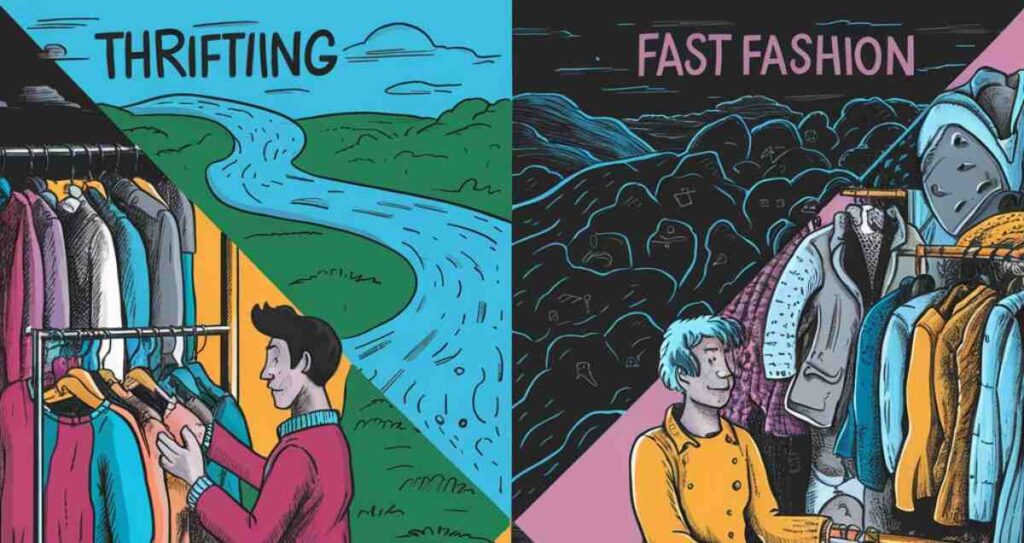The Statement Of The Problem Thrifting Vs Fast Fashion of the problem explores the environmental, social, and economic impacts of fast fashion versus thrifting, focusing on sustainability and consumer choices.
Is your closet helping or harming the planet? Discover how thrifting and fast fashion shape our world, and why your choices matter more than ever.
Fast fashion produces trendy clothes quickly and cheaply, but at great environmental and ethical costs. Thrifting offers a sustainable alternative, reducing waste and promoting reuse. This comparison highlights the challenges and benefits of each approach, encouraging mindful consumption.
Mastering the Statement of the Problem: Thrifting vs. Fast Fashion

Fashion has always been a reflection of culture, lifestyle, and personal expression. Today, the industry faces a major crossroads: sustainability versus convenience. On one side, fast fashion dominates with its low prices and ever-changing trends. On the other, thrifting offers a sustainable, budget-friendly way to shop while reducing waste. This article examines the Statement Of The Problem Thrifting Vs Fast Fashion, and explores their environmental, economic, and social impacts.
We’ll delve into the issues plaguing fast fashion, why thrifting is gaining popularity, and how the two approaches shape the future of fashion. Along the way, we’ll provide actionable insights, examples, and a deep dive into the choices we make as consumers.
What Is the Problem?
The rapid rise of fast fashion has created a global environmental crisis. Clothing production has doubled in the past 20 years, yet most garments are discarded within months. Meanwhile, thrifting emerges as an alternative, promoting reuse and reducing waste.
However, it faces its own set of challenges, such as limited availability and accessibility in certain regions.
Key Problems with Fast Fashion
- Overproduction: Clothing brands produce large quantities to meet ever-changing trends, leading to overstock and waste.
- Waste Generation: The average American discards 81 pounds of clothing annually.
- Exploitation: Fast fashion often relies on underpaid labor in unsafe conditions.
Thrifting Challenges
- Limited Sizing: Second-hand stores may not have sizes or styles for everyone.
- Quality Control: Thrifted items vary greatly in condition and durability.
- Accessibility: Thrifting isn’t as widespread or convenient as fast fashion stores or online shopping.
Fast Fashion: Definition, Benefits, and Issues
Fast fashion refers to the mass production of inexpensive clothing designed to mimic current trends. Retail giants like Zara, H&M, and Shein are synonymous with this model, offering new collections almost weekly.
Benefits of Fast Fashion
- Affordability: Lower costs make fashion accessible to people with limited budgets.
- Convenience: With countless stores and online platforms, fast fashion is readily available.
- Trendy Designs: Consumers can quickly adopt the latest styles without breaking the bank.
Issues with Fast Fashion
- Environmental Costs
- Produces 10% of global carbon emissions.
- Uses vast amounts of water; for example, one cotton shirt requires 700 gallons of water to produce.
- Synthetic fabrics like polyester release microplastics into water systems during washing.
- Ethical Concerns
- Factories often operate in developing countries where workers are paid below living wages.
- Child labor remains a concern in many supply chains.
- Planned Obsolescence
- Clothing is intentionally made to last only a few wears, encouraging more purchases.
Thrifting: Definition, Benefits, and Challenges

Thrifting involves purchasing second-hand clothing from thrift stores, online resale platforms, or charity shops. Over the years, it has grown in popularity due to its affordability, unique finds, and environmental benefits.
Benefits of Thrifting
- Sustainability
- Reduces landfill waste by extending the lifespan of clothing.
- Lowers demand for new production, conserving natural resources.
- Affordability
- Allows consumers to purchase high-quality or branded items at a fraction of the cost.
- Individuality
- Offers unique pieces that stand out from mass-produced trends.
Challenges of Thrifting
- Limited inventory and unpredictable stock make it harder to find specific items.
- The rise in demand for second-hand clothing has led to inflated prices in some regions.
- Thrifted items may require repairs or alterations.
Comparing Thrifting and Fast Fashion
The debate of thrifting vs. fast fashion comes down to three key areas: economic, environmental, and social impacts.
Economic Impact
| Aspect | Fast Fashion | Thrifting |
|---|---|---|
| Cost to Consumers | Low upfront cost | Often cheaper but requires time to search. |
| Economic Cycle | Drives rapid production and sales. | Supports local charities or thrift store businesses. |
| Longevity of Items | Short lifespan, encouraging repeat purchases. | Longer-lasting if carefully selected. |
Environmental Impact
Fast fashion is one of the biggest polluters globally, while thrifting significantly reduces waste.
- Fact: The fashion industry emits more carbon annually than international flights and maritime shipping combined.
- Thrifting cuts down on waste by giving garments a second life, lowering the demand for new clothing production.
Social Impact
Fast fashion’s reliance on cheap labor often perpetuates inequality, while thrifting supports local communities and charities. However, the growing popularity of thrifting raises concerns about affordability for low-income shoppers who rely on second-hand clothing.
Case Studies: Real-World Insights
Bangladesh Garment Industry
Fast fashion has brought economic growth to Bangladesh but at a cost. Factory collapses, such as the 2013 Rana Plaza tragedy, highlighted the industry’s exploitative practices and unsafe working conditions.
Rise of Online Thrift Stores
Platforms like ThredUp and Poshmark have made thrifting more accessible. These platforms report that resale fashion is growing 21 times faster than the traditional retail sector.
The Future of Sustainable Fashion

Fashion brands are beginning to recognize the demand for sustainability. Many are introducing “conscious collections” or partnering with resale platforms. Consumers, too, play a crucial role by prioritizing quality over quantity and exploring alternatives like thrifting.
Actionable Tips for Consumers
- Opt for timeless pieces that outlast fleeting trends.
- Donate gently used clothing instead of discarding it.
- Support brands committed to ethical and sustainable practices.
Conclusion
Statement Of The Problem Thrifting Vs Fast Fashion—boils down to conscious choices. Fast fashion offers convenience, but at an environmental and social cost. Thrifting, while imperfect, provides a sustainable alternative that aligns with modern values of eco-friendliness and individuality.
As a consumer, your choices have the power to shape the future of fashion. By embracing thrifting and supporting ethical practices, you contribute to a healthier planet and a more equitable world. Choose wisely; your wardrobe can make a difference.
Welcome to FashionTrista! I’m David Mark, and I’m excited to share my passion for fashion with you. At FashionTrista, we offer a curated selection of the latest trends, style tips, and fashion advice to keep you ahead of the curve. Whether you’re looking for outfit inspiration or expert guidance, FashionTrista is your go-to resource for all things fashion. Explore with us and redefine your style journey.
